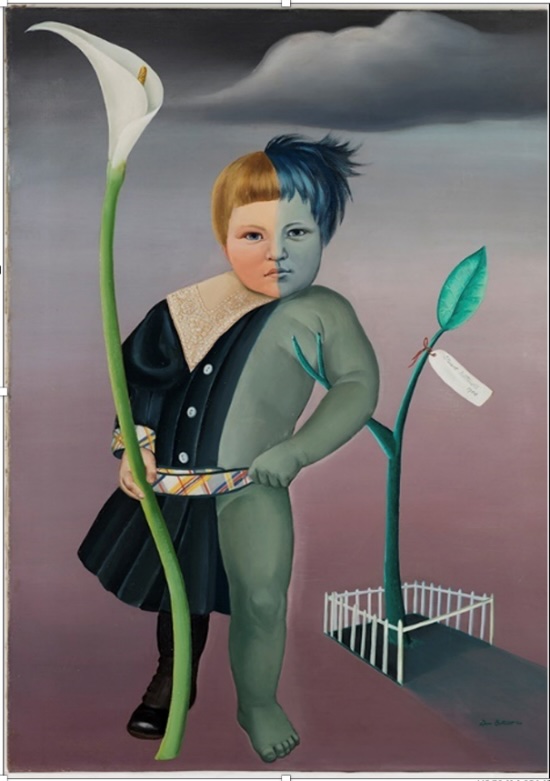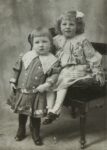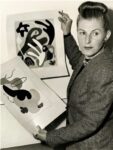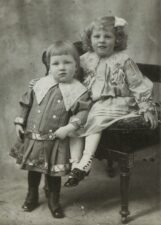

Dorr Bothwell
American, 1902-2000
Family Portrait, 1940
Oil on canvas
33 1/2 x 23 3/4 in.
SBMA, Museum purchase with funds provided by the General Art Acquisition Fund
2019.14

Dorr Bothwell displays artists’ works, September 1945. Photo courtesy of San Francisco Library
“When no preconceived ideas keep us from looking and we take all the time we need to really “feel” what we see – when we are able to do that – the universe opens up and we catch our breath in awe ….It is only when this happens that we regain our sense of wonder.” - Dorr Bothwell
RESEARCH PAPER
“Family Portrait” is inspired by a family photograph. In her auto biography Bothwell related this story about the photo.
“My grandmother would come to visit us every few years. Then, after she returned to her home in London, she would go over to Paris and buy us clothes. She had our measurements and allowed for our growth. Soon a trunk would come with all these wonderful hand-made clothes, but not a single child in San Diego, California, was wearing things like we had. I didn’t care, but my brother would get so upset because he didn’t look like everybody else and would cry himself into a fever. He was teased mercilessly. …My father just could not understand this—he didn’t have much sympathy. But finally they had to give in because Stuart cried himself sick. I mean that—he was in bed!” (Bothwell, Straws in the Wind) .
In “Family Portrait” we see a small boy in a dress with an alternate self, leaving his body. His dress transforms into a greenish gray figure, and his hair becomes dark and blows in the wind signaling a liberation from the coiffed and well-dressed constraints of his life. Smoky dark clouds pass overhead suggesting distress in his dreams. He holds a Calla lily. Callas, (Greek for beauty), are associated with innocence (the young boy), beauty, rebirth ( perhaps in his dreams) and union (the dual figure).
An almost unreal, neon green tree sprouts from an open pen (a burial plot?) and grows under his arm suggesting a desire to become one with nature. The tree is labelled with his name, “Stuart,” and birthdate. The gate enclosing the tree is partly open, with a garden path leading away, a metaphor for escape. The boy is painted against a flat, grayed out ombre background that transitions from purple to grays. His pose is forward looking formal and mildly defiant.
Bothwell’s forms have a crystalline clarity and meticulous outlines. The flat painted surfaces have emotionally suggestive planes of color. On one side of the boy we see realistic colors in both the boy and the calla lily. On the other side, distorted, somewhat eerie tones predominate. There is a palpable tension. Notably, there is an absence of shadow.
In her painting “Family Portrait “ Bothwell explores Stuart’s dreams as conduits for unspoken feelings and desires. The work creates a dialogue between the perceptual (the images of the boy and plants) and conceptual, (the boy’s story) a hallmark of California surrealism.
“Surrealism” (from the French “Sur Realisme” meaning superior reality) emerged as a movement influenced by Freud and the horrors of World War I. Artists sought to probe the subconscious through radical new methods and forms ranging from free-association drawings to hyper-realistic painted scenes with uncanny juxtapositions. (MOMA) Bothwell’s variation of surrealism involved arranging objects to evoke a particular idea. “Family Portrait “ is an example of this blending real life inspiration with fantasy to transform the every day. The boy’s identity conflict echoes Freudian dilemma.
In life, Dorr Bothwell was courageous, determined, adventurous, and talented. She was truly a remarkable woman, and no simple recitation of her accomplishments can tell her story. Some anecdotes show this exceptionalism.
Bothwell (1902 -2000) was born in San Francisco to Scottish-Canadian Immigrant parents. Known as a Symbolist, she was a painter, potter, printmaker, art teacher and author. Born Doris Hodgson Bothwell, she changed her name to “Dorr “after her first exhibition entry was rejected in 1924. Female colleagues advised her to avoid signing her first name to avoid gender discrimination from male reviewers. “Dorr,” a childhood nickname was made legal.
Dorr attended college, but never graduated. Her “college” was her life experience. At 26 she went to Samoa on the heels of Margaret Meade. In 1928, as a lone woman with no birth certificate to clearly identify her (hers was burned in the San Francisco fire of 1906), she faced resistance from the US Navy, who initially refused to allow her to stay. A local chief adopted her and inducted her into his tribe by tattooing her legs. This allowed her to remain, and her experience deeply influenced her work. Her art began to feature tapa-like designs and vibrant Gauguin inspired colors.
In the 1930’s, while in Berlin, Bothwell witnessed the dramatic rise of antisemitism. A shopkeeper she recognized from San Francisco refused to wait on her, disappearing behind the counter. The next day she saw Jude written on nearby shops and understood the growing threat. She soon returned home.
In the 1960’s, Bothwell travelled to Nigeria. After finishing a teaching assignment, she joined a small group attempting to reach the West African Coast. One night, they encountered Tuareg people whose skin was darkened by the blue dye used in their clothing. Fearing kidnapping or robbery, they distracted the group by offering them gifts of clothing and navigated across the desert with a compass. Her adventurous travel punctuated her entire life and influenced her art. She funded herself by sending back her art from various countries to her galleries.
Her art trajectory began in the early 1920s when she studied at the California School of Fine Arts (now the San Francisco Art Institute) with colorist Rudolph Schaeffer (1886-1988). In 1925, she became a charter member of the San Francisco Society of Women Artists. San Francisco was an intermittent home base for much of her life.
After travel to Samoa, Australia, and then Europe, she returned to SF. At first the lack of a college degree hampered her ability to get good work; she wanted to teach. Out of work and living on rain water, Bothwell met Lorser Feiteleson and through him, she discovered the WPA. He gave her work painting murals in Los Angeles and in addition to keeping her from starving, cemented her interest in post surrealism. This employment sustained her monetarily and artistically.
During the late thirties she painted remarkable, often haunting, enigmatic dreamscapes, and her abstract works on paper caught the attention of East Coast critics in the mid-forties. She began making screenprints in 1943 after seeing an exhibition of serigraphs. When museums and galleries questioned the medium’s viability as fine art, Bothwell embraced it. Her work transitioned from representational surrealism to Abstract Expressionism. Her screenprints often featured Native-American motifs, surrealist influences, and geometrical designs with vivid color. From 1944 until 1996 she taught at the San Francisco Art Institute, where she once studied, but had been unable to teach due to her lack of the college degree. In 1960, Bill Zacha invited her to live and work in his Mendocino Art Colony. In 1968, she co-authored “Notan: The Dark-Light Principle of Design,” with Marlys Frey, which examined positive and negative forces as the basis for compositional design. Bothwell undertook travel studies to Nigeria and Tunisia in 1966-7 and to Bali, Java and Sumatra in 1974, where she documented craft techniques. She spent half of her time living in Joshua Tree, CA and did several stints working with Ansel Adams in Yosemite. In 1998 she donated a large archive of her prints to the Mendocino Art Center. Bothwell died in 2000 in Mendocino, at the age of ninety-eight. Her work is included in major museums world-wide.
Prepared for the Santa Barbara Museum Docent Council by Susie Thum, 2025.
BIBLIOGRAPHY
The British Museum. “Dorr Bothwell.” https://www.britishmuseum.org/collection/term/BIOG20385.
Accessed 11/22/2024.
Bothwell, Dorr and Marlys Frey, “NOTAN, the Dark-Light Principle of Design,” Van Norstrand Rheinhold, New York, 1968 pp 1-79.
Calabi Gallery. "Dorr Bothwell." https://calabigallery.com/artists/dorr-bothwell/. Accessed 11/22/ 2024.
Karlstrom, Paul J., editor On the Edge of America: California Modernist Art, 1900-1950. Berkeley: University of California Press, c1996. http://ark.cdlib.org/ark:/13030/ft5p30070c/. Accessed 11/23/2024
MOMA Art and Artists-Surrealism https://www.moma.org/collection/terms/surrealism.
Mutual Art Biography, Articles, Auction Results, Exhibitions, Performances, Artworks ( 59) https://www.mutualart.com/Artist/Dorr-Bothwell/66502C61BD53C6AE/Biography, Accessed 11/26/2024.
Oliver, Myrna. “Dorr Bothwell: Painter Lived a Nomadic Life.” The Los Angeles Times, September 28, 2000, https://www.latimes.com/archives/la-xpm-2000-sep-28-me-27856-story.html.
Quinn, Kelly. “I’ll Pretend That I Am Going to ‘Art School’: Dorr Bothwell in Samoa, 1928-1929.” Archives of American Art Journal 52, no. 1/2 (2013): 70–79. http://www.jstor.org/stable/43155569. Accessed 11/15/2024.
Yungee. "The Modern Gallery: 1926-1927." 2024. https://yungee.com/the-modern-gallery.
San Francisco Airport Museum,
https://www.sfomuseum.org/exhibitions/california-modernist-women/gallery#5. Accessed 11/24/2024.
Zacha’s Bay Window Gallery. “Dorr Bothwell (1902-2000).” https://www.williamzacha.com/artists/dorr-bothwell/about-dorr-bothwell/. Accessed 11/22/ 2024.
Zacha’s Bay Window Gallery. Dorr Bothwell: Straws in the Wind: An Artist’s Life as told to Bruce Levene. https://www.williamzacha.com/artists/dorr-bothwell/straws-complete/ Accessed 11/22/2024.

Photograph of Dorr and her brother Stewart,1906, courtesy of the Dorr Bothwell Trust
